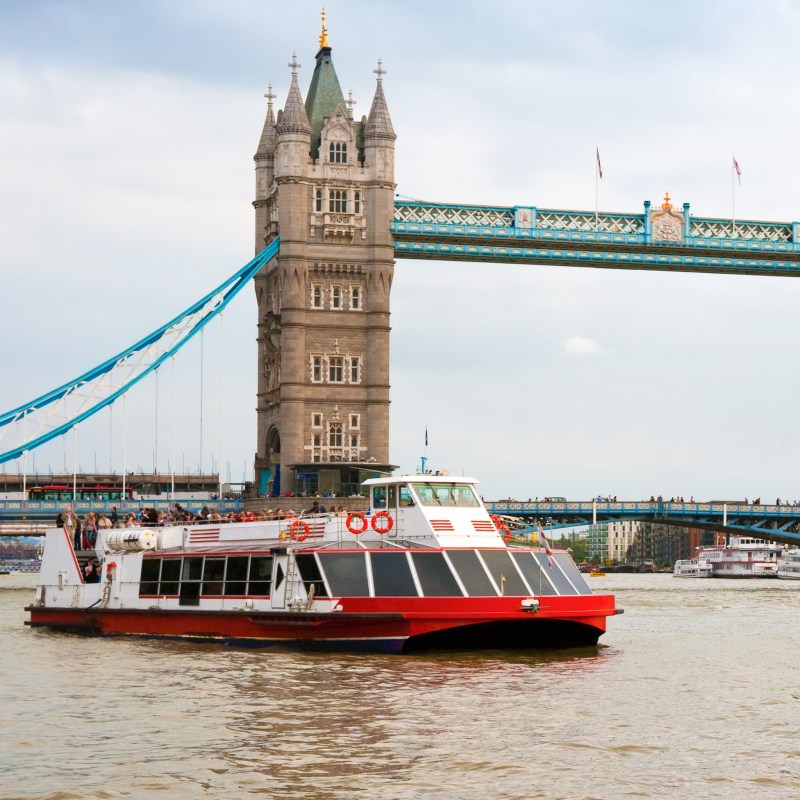
London is a river city. The broad River Thames enters from the west and curves its way through the metropolis to the North Sea. En route, it passes glass and steel urban London, green parks, and former riverside villages.
Videos by TravelAwaits
The river used to be London’s highway. It still is, for some. You can use riverboats within the Transport for London River Bus system as part of your tourist day. The Westminster Pier to the Tower of London is a nice ride.
For something fancier — maybe including a meal, entertainment, or a guided tour — there are private services to choose from.
The routes and features change from time to time. Visit London and Transport for London are good starting points for up-to-date information. The Transport for London site has multiple pages about river travel, including The River Experience, with details of how to get to a number of popular attractions by boat.
The view from the River Thames reveals history and some spectacles of modern life.
After-dark cruises show off the artistic lighting on the growing number of bridges included in the Illuminated River, a long-term project that will eventually feature 14 bridges.
When you’re strolling along the river and pass by one of the piers, take a look at the schedules. Remember that these can change according to the tide or weather conditions.
Here are some of the best river cruises on which to experience the River Thames.

1. Tate To Tate Cruise
The Tate Modern and the Tate Britain are two of London’s best-loved art galleries. You can travel between them by bus or Tube, but the boat is more fun.
The journey between the Bankside Pier and the Millbank Pier via the Thames Clippers service takes about half an hour. Check the Tate Boat website for current information and tour possibilities.
To do a little local exploring, from the Tate Modern, see the Bankside district on foot or cross the Millennium Bridge to reach Saint Paul’s Cathedral. You may see licensed mudlarkers exploring the foreshore at low tide.
From the Tate Britain, you can take the bus or walk about 15 minutes to Westminster Abbey and the Houses of Parliament.
2. All-Day Red Rover Hop-On, Hop-Off Cruise
City Cruises offers a hop-on, hop-off cruise connecting three piers: Westminster, London Eye, and Tower. The ticket is good for 24 hours, and the onboard commentary lets you know what you’re passing.
3. Thames River Dinner Cruises
Several companies offer boat rides plus a meal. These dinner cruises advertise tempting menus served with a view. A cruise with a meal may need to be booked in advance.

4. Sunday And Special Occasion Cruises
Viscount Cruises operates a long-established 2-hour Sunday evening cruise starting and ending at Greenwich. It runs from May through September and offers a chance to see Maritime Greenwich, a UNESCO World Heritage site, from the water.
Be sure to allow time to explore Greenwich by day, too. The National Maritime Museum, Royal Observatory, Saint Alfege Church, and Cutty Sark are just some of the attractions of this historic seaside town. Greenwich also has a pedestrian tunnel underneath the Thames. The entrance is close to the Cutty Sark.
On special occasions, like Valentine’s Day or Mother’s Day, there may be themed cruises. In the United Kingdom, Mother’s Day is called Mothering Sunday and falls three weeks before Easter.
5. Bonfire Cruises
Bonfire Night, or Guy Fawkes Day, is officially on November 5, but the actual lighting of fireworks is no longer confined to one night. Some companies offer special Bonfire Night cruises to see the fireworks at Battersea Park.
6. James Bond-Style Cruises
Fans of 007 will remember him zipping down the Thames in a speedboat. If you’re all about adrenaline, the rigid inflatable boat experience might be for you. Try it as a stand-alone trip or as a 45-minute ride combined with a 3-hour land tour of James Bond-connected locations.

7. Free Woolwich Ferry
Woolwich isn’t high on most tourists’ agendas, but if you like history, I would recommend the Royal Arsenal area. This was, for centuries, a key military establishment, housing the Royal Dockyard, the Royal Arsenal, the Royal Military Academy, and more.
Today, many of the buildings and spaces are being repurposed as part of an ambitious urban redevelopment project. I love exploring this site, with its historic buildings, waterfront, and (to my surprise) an installation of Antony Gormley’s art.
The Royal Arsenal is where the famous Arsenal Football Club started. There’s even a bronze monument of a soccer ball near the Dial Arch pub to commemorate this.
You can combine a visit to the Royal Arsenal development with a cross-river ride on the free Woolwich Ferry. If the ferry isn’t running, there’s another unique way to cross. Try the Woolwich Foot Tunnel under the Thames.

8. Thames Barrier Cruise
Unlike other sights you can see from the water, the Thames Barrier is in the water. Downstream from Greenwich, the barrier was completed in 1982 to protect London from flooding. This is an amazing work of engineering and construction.
Thames River Sightseeing is one company offering a boat tour to the Thames Barrier.

9. Hampton Court Palace By Boat Cruise
London is much bigger than the touristy sections. A ride upstream will show you places you’re not likely to see in a completely land-based visit. You can make this journey in either direction.
This trip is not for everyone — the trip from Westminster Pier to Hampton Court Palace by boat can take 4 hours! The time varies depending on the tide. The River Thames is tidal as far as Teddington Lock. I love the long ride, but if you want to get from Point A to Point B quickly, this is not the way.
For a shorter cruise, Turks runs boats from Richmond upon Thames through the lock and then to Kingston upon Thames and on to Hampton Court Palace.
Starting from Westminster Pier, one of the first sights to look out for is the Palace of Westminster, usually called the Houses of Parliament. Other notable buildings in the area are the Thames House, home of MI5, by the Lambeth Bridge, and the MI6 building before the Vauxhall Bridge.
The massive Battersea Power Station, with its four towers, is being redeveloped for housing and shops.
From Putney Bridge to Mortlake is the Boat Race course. Rowers of all abilities practice on the Thames in all kinds of weather on this stretch.
At Hammersmith, there’s an elegant Victorian suspension bridge and some popular pubs right along the river.
From here upstream are some of the best views of old riverside London, not yet concealed and altered by modern developments.

At Kew Pier, the boat may stop for visitors to the world-famous Kew Gardens. The red brick building with many chimneys is Kew Palace, a former home of King George III and one of London’s Historic Royal Palaces.
The village of Isleworth, with its square church tower and London Apprentice pub, has been a favorite subject of artists, including J. M. W. Turner.
After the Richmond Lock, the boat may also stop at Richmond. The White Cross pub just before the bridge has a special high-tide door for when the regular door is underwater.
After Richmond, you’ll spot several historic houses, including Ham House, Marble Hill House, and Orleans House. The hidden remnants of Alexander Pope’s Grotto are just past Eel Pie Island.
Passing through Teddington Lock is always an adventure. The water level changes by about 9 feet. After Kingston, Hampton Court Palace itself comes into view, just as it did for King Henry VIII when he accepted it as a gift from Cardinal Thomas Wolsey in 1529.
What To Know Before You Go
In addition to boats on the Thames, London has a network of canals, a reminder of its industrial heritage. People use the canals for pleasure boating. Some even live year-round in canal boats! Canal trips run between Camden Lock and Paddington Basin. The Canal Museum has information about boat trips as well as the canals themselves.
Many boats on the Thames have on-deck seating, but not all.
The distinction between the River Bus and other boats can be confusing. The River Bus is part of the Transport for London system and accepts Oyster cards. Boats that don’t accept Oyster cards to board may still let you pay for a paper ticket using an Oyster card. I have always found the people working at the piers to be very helpful.
The Transport for London website explains the fares and has a downloadable map.
